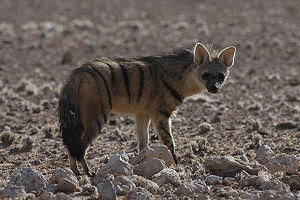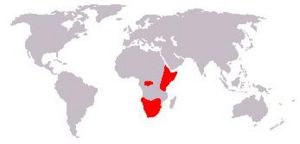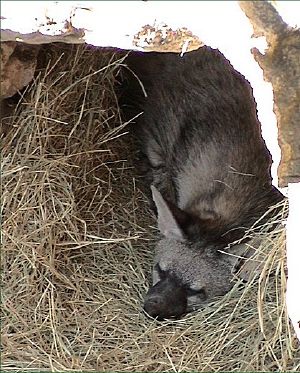Aardwolf
- For other uses, see Aardwolf (disambiguation).
| Aardwolf
| ||||||||||||||||
|---|---|---|---|---|---|---|---|---|---|---|---|---|---|---|---|---|
 Aardwolf
| ||||||||||||||||
| Scientific classification | ||||||||||||||||
| ||||||||||||||||
| Proteles cristatus Sparrman, 1783 | ||||||||||||||||
 Aardwolf range
|
The aardwolf (Proteles cristatus) is a small, insectivorous hyena-like mammal, native to Eastern and Southern Africa. The name means "earth wolf" in Afrikaans/Dutch.[2] It is also called "maanhaar-jackal" and "protelid". Unlike other hyenas, the diet of the aardwolf almost completely consists of termites, other insect larvae and carrion.[3]
The aardwolf is the only surviving species of the subfamily Protelinae. Two geographically separate subspecies are recognized: Proteles cristatus cristatus of Southern Africa, and Proteles cristatus septentrionalis of eastern and northeastern Africa.[4][5] It is usually placed in the Hyaenidae, though formerly separated into a monotypic family, Protelidae. The aardwolf lives in the scrublands of eastern and southern Africa. These are the areas of land covered with stunted trees or shrubs. The aardwolf hides in a burrow during the day and comes out at night to search for food. It is related to hyenas, but unlike its relatives, it does not hunt large prey . This unusual animal is a mass killer-of insects. It feeds mainly on termites and can eat more than 200,000 in a single night, using its long, sticky tongue to collect them.
- Hyena (or Hyæna) is any terrestrial mammal in the subfamily Hyaeninae of the Hyaenidae of the order Carnivora, typically characterized by a dog-like appearance, powerful jaws, and hind limbs shorter than fore limbs. There are three extant (living) species of hyenas: Crocuta crocuta (spotted hyena or laughing hyena), Hyaena hyaena (striped hyena), and Parahyaena brunnea (brown hyena). A fourth living member of the Hyaenidae family is Proteles cristatus (the aardwolf); however, it is a member of the Protelinae subfamily. The Hyaenidae family is also known as the hyena family, and all members of this family, including the aardwolf, are sometimes designated as hyenas.
- Hyenas bear some physical resemblance to canids. However, they are placed in a biological family that is most closely related to Herpestidae (the family of mongooses and meerkats). The three living species of hyenas have among the strongest jaws in the animal kingdom and an adult of the species has only the big cats (lions) to fear. The fourth member of the hyena family, the insectivorous aardwolf, does not have such powerful jaws, given its diet consists mainly of termites, other insect larvae, and carrion.
- All three hyena species, and the aardwolf, have a distinctly bear-like gait and sloping posture due to their front legs being longer than their hind legs. The aardwolf, striped hyena, and brown hyena have luxurious, striped pelts and manes lining the top of their necks, which erect when frightened. The spotted hyena's fur is considerably shorter and is spotted rather than striped. Unlike other species, its mane is reversed forwards.
Physical characteristics
The aardwolf looks most like the Striped Hyena, but is significantly smaller with a pointier muzzle, sharper ears used for listening for harvester termites, black vertical stripes on a coat of yellowish fur, and a long, distinct mane down the middle line of the neck and back, which is raised during a confrontation to make the aardwolf's size appear bigger. It is 55–80 cm long, excluding its bushy 20–30 cm tail, stands about 40–50 cm at the shoulder, and weighs between 9 and 14 kg.[3] Its front feet have 5 toes, unlike other hyenas which have four toes.[4] Its teeth and skull are similar to that of the hyena, although the cheek teeth are specialised for eating insects, and its tongue for licking them up.[4] As the aardwolf ages, it will normally lose some of its teeth, though this has little impact on their feeding habits due to the soft nature of the insects they consume.[3] It has two glands at the rear that secrete a musky fluid for marking territory and communicating with other aardwolves.
Distribution and habitat
The aardwolf lives on open, dry plains and bushland, while avoiding mountainous areas. Due to its specific food requirements, the animal is only found in regions where termites of the family Hodotermitidae occur. Termites of this family depend on dead and withered grass and are most populous in heavily grazed grasslands and savannahs, including farmland. For most of the year, aardwolves spend time in shared territories consisting of up to a dozen dens which are occupied for six weeks at a time. [3]
There are two distinct populations: one in Southern Africa, and another in East and Northeast Africa. The species does not occur in the intermediary miombo forests.
Behavior

Aardwolves are shy and nocturnal, sleeping in underground burrows by day.[4] They usually use existing burrows of aardvarks, Old World porcupines or springhares, despite being capable of creating their own. By night, an aardwolf can consume up to 200,000 harvester termites using its sticky, long tongue.[3] They take special care not to destroy the termite mound or consume the entire colony, which ensures that the termites can rebuild and provide a continuous supply of food. They will often memorise and return to nests to save the trouble of finding a new one. They are also known to feed on other insects, larvae, and eggs, and occasionally small mammals and birds. Unlike other hyenas, aardwolves do not scavenge or kill larger animals.
The aardwolf is primarily solitary (especially males), but a mating pair will occupy the same territory with their young. Young aardwolves generally achieve sexual maturity after two years, and the breeding season varies depending on their location, but normally takes place during the autumn or spring. During the breeding season, male aardwolves will search their own territory as well as others' for a female to mate with. This can often result in conflict between two male aardwolves when one has wandered into another's territory. Gestation lasts between 90 and 110 days, producing one to five cubs (most often two or three) during the rainy season, when termites are active.[4] The first six to eight weeks are spent in the den with the mother. After three months, they begin supervised foraging and by four months are normally independent. However, they will often use the same den as their mother until the next breeding season. They can achieve a lifespan of up to 15 years when in captivity.
Interaction with humans
The aardwolf has taken advantage of the development of agriculture in the continent.[citation needed] They are often considered useful, non-dangerous animals by farmers. However, in some areas the aardwolf is hunted for its fur. Encounters with dogs are another threat.
- Aardwolf (Harvard University).JPG
Proteles cristatus
ReferencesISBN links support NWE through referral fees
- ↑ Hyaena Specialist Group 1996. [1]. 2006 IUCN Red List of Threatened Species., World Conservation Union. Retrieved on 12 May 2006.
- ↑ "Aardwolf (Proteles cristatus)". Encyclopaedia Britannica. (2007). Encyclopaedia Britannica Online.
- ↑ 3.0 3.1 3.2 3.3 3.4 (1994) Wildlife Fact File. IMP Publishing Ltd, Group 1, Card 144. ISBN 08-50-04-0016.
- ↑ 4.0 4.1 4.2 4.3 4.4 "aardwolf." Encyclopædia Britannica. 8 Jan. 2007
- ↑ Molecular systematics of the Hyaenidae
External links
| ||||||||||||||
Credits
New World Encyclopedia writers and editors rewrote and completed the Wikipedia article in accordance with New World Encyclopedia standards. This article abides by terms of the Creative Commons CC-by-sa 3.0 License (CC-by-sa), which may be used and disseminated with proper attribution. Credit is due under the terms of this license that can reference both the New World Encyclopedia contributors and the selfless volunteer contributors of the Wikimedia Foundation. To cite this article click here for a list of acceptable citing formats.The history of earlier contributions by wikipedians is accessible to researchers here:
The history of this article since it was imported to New World Encyclopedia:
Note: Some restrictions may apply to use of individual images which are separately licensed.



